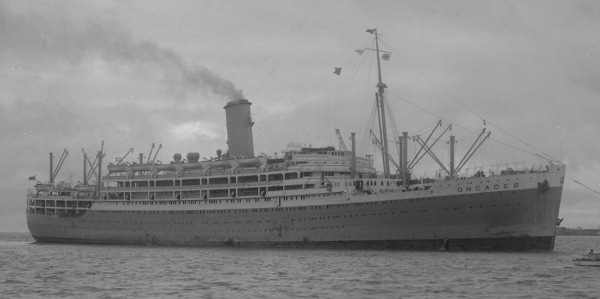Orcades
British Troop transport

Photo courtesy of Allan C. Green Collection
| Name | Orcades | ||
| Type: | Troop transport | ||
| Tonnage | 23,456 tons (one of the largest ships sunk). | ||
| Completed | 1937 - Vickers-Armstrongs Ltd, Barrow-in-Furness | ||
| Owner | Orient Steam Navigation Co Ltd, London | ||
| Homeport | London | ||
| Date of attack | 10 Oct 1942 | Nationality: | |
| Fate | Sunk by U-172 (Carl Emmermann) | ||
| Position | 35° 51'S, 14° 40'E - Grid GR 7335 | ||
| Complement | 1067 (45 dead and 1022 survivors). | ||
| Convoy | |||
| Route | Suez - Capetown (9 Oct) - Liverpool | ||
| Cargo | 741 passengers, 3000 tons of general cargo and 2000 bags of parcel post | ||
| History | Completed in July 1937. In 1939 the steam passenger ship was requisitioned by the Ministry of War Transport (MoWT) as troopship. | ||
| Notes on event | At 10.28 hours on 10 Oct 1942 the unescorted Orcades (Master Charles Fox) was hit on the port side by two torpedoes from U-172 while steaming on a zigzag course at 15 knots about 220 miles southwest of Capetown. The ship was running at a slower speed as usual in order to conserve fuel as she was heading directly for the UK and rain showers had reduced the visibility. The first torpedo struck between #1 and #2 holds and the second in #6 hold, disabling the port engine and the steering gear. The master ordered the crew to prepare the lifeboats and to send distress signals and consequently most of the crew and passengers abandoned ship after she was hit on port side amidships in #3 hold by a third torpedo at 10.45 hours. The hatches were blown off #6 and #3 holds and the ship settled slowly on even keel, slightly down by the head. The abandonment proved to be difficult in rough seas and heavy swell and the ship still making headway, but 20 lifeboats were launched without mishap. One capsized and its occupants were picked up by one of the motor boats, while another became waterlogged upon launch and was last seen drifting away with the most persons who were later reported missing and probably drowned when this boat eventually sank. A skeleton crew and the gunners remained behind and tried to save the vessel, among them were volunteers from the passengers that helped manning the armament of one 6in, one 3in, four 20mm and five machine guns and a petty officer telegraphist who sent a second distress signal after the radio operators had abandoned their station. At 10.54 hours, the U-boat fired a fourth torpedo that malfunctioned and missed. Afterwards the Germans had first to reload one bow torpedo tube because no attack could be carried out with the stern torpedoes on the Orcades, which was running in circles at 5 knots. However, in the meantime the engineers managed to restart the port engine and the ship began heading towards the coast at about 8 knots, steering with the screws only. U-172 surfaced to overtake her but had to dive again when the gunners opened fire, not knowing that they haven’t actually spotted them but fired at something they thought was a periscope. At 12.49 hours, the U-boat fired another torpedo that hit on starboard side aft in #6 hold, followed by a fifth and sixth torpedo hit at 12.50 and 12.54 hours. The torpedoes struck on the starboard side in the engine room and forward of amidships and caused the ship to sink with a broken back and a heavy list to starboard about six minutes after the last hit. Shortly afterwards an aircraft attacked the U-boat on periscope depth, causing no damages but forcing it to leave the area submerged without questioning the survivors. After the fourth torpedo hit, the remaining 55 men immediately abandoned ship in the last four lifeboats or jumped overboard and swam to rafts that were released. However, the chief engineer failed to leave the ship. The four boats then picked up all men who were on rafts or clung to debris, also recovered many oranges from the cargo and were then tied together, awaiting rescue close to the sinking position. The aircraft had reported their position and the Polish steam merchant Narwik (Master Czeslaw Zawada) located the lifeboats a few hours after the sinking, stopped and her crew worked tirelessly for the next seven hours to pick up more than 1000 people without accidents despite rough seas and the constant danger of being torpedoed herself. The ship even carried out a search for three lifeboats that were unaccounted for until 03.30 hours on 11 October and then headed towards the South African coast at 9 knots. After ten hours, she was joined by HMAS Nizam (G 38) (Cdr M.J. Clark, DSO, RAN) and HMS Foxhound (H 69) (LtCdr G.H. Peters, RN) which escorted her to Capetown, arriving on 12 October. The arrival of the destroyers had been delayed by the sighting of U-159 (Witte) in 35°51S/16°24E at 06.29 hours on 11 October. They gained no contact after the U-boat crash dived and soon left without carrying out a depth charge attack, but warned Narwik about its presence and the area was avoided. Orcades carried a complement of 290 crew members, 36 gunners and 741 passengers (mostly service personnel returning to the UK) of which 45 persons were lost: 27 crew members, two gunners, two civilian passengers, seven naval personnel and seven army personnel. | ||
| On board | We have details of 103 people who were on board. | ||
If you can help us with any additional information on this vessel then please contact us.
